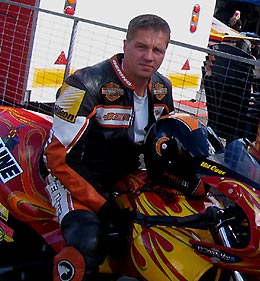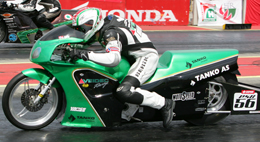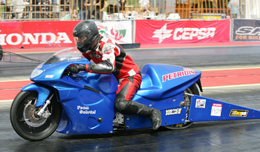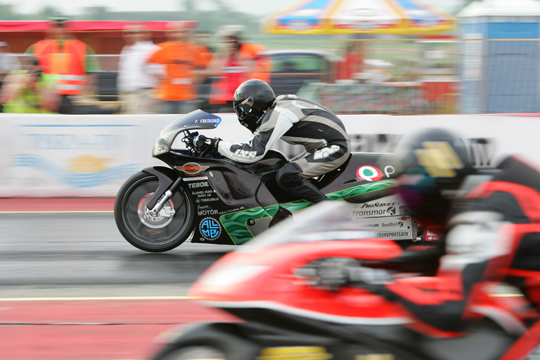Denmark
 Finland
Finland  Germany
Germany 
Greece
 Hungary
Hungary  The Netherlands
The Netherlands  Norway
Norway  Sweden
Sweden  United Kingdom
United Kingdom 
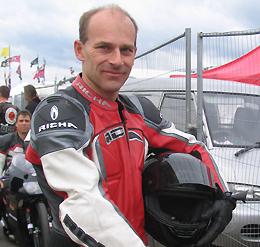
European record holder:
Dave Beck, UK
elapsed time: 7.067 sec
speed: 302.91 km/h (188.25 mph)
To learn more about Pro Stock Bike, we interviewed UK based Stephen Moon, who is highly involved in the European record holding team Dave Beck Racing.
Can you tell us the facts in brief? What performance/power/fuel/cylinders are we looking at?
There are two engine configuration types in UEM PSB, the 2,600cc twin-cylinder Buell motors as used by Ulf Ogge and the four-cylinder Suzuki motors, which can range in size from 1500cc to 1755cc. There are UEM prescribed minimum weight breaks for each motor configuration, in order to keep the class competitive. Regardless of engine configuration, the bikes all run on unleaded petrol and are naturally aspirated, using either carburettors or fuel injection. Power is transmitted to the track through a ten inch slick. The current class ET record is 7.07 seconds, by the UK rider Dave Beck, but already this season Jesper Thiel has come very close to that mark at the Hungarian season opener. Terminal speeds are in the mid-180s. So very impressive performances for normally-aspirated petrol engines. The competitors tend to be very cagey about the power outputs, but it’s safe to say the leading riders have 350bhp at their disposal.
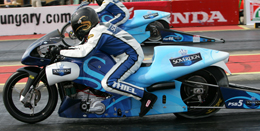
Jesper Thiel from Denmark is after Becks record
What has the evolution been like in recent years in terms of technology Performance? The class as regards to number of teams, etc..?
The class has developed very strongly in recent years, as evidenced by the number of teams, the appearance of new riders and some very close racing indeed. Sixteen bike eliminations are the norm and indeed the Main Event sees a full field contesting this premier event. A full quarter of the field now consists of the twin cylinder Buells, including reigning UEM Champion Ulf Ogge. The rest of the field consists of four cylinder Suzukis, which this year will see a number of 1755cc bikes competing to take advantage of the new rules. The Veidec Racing team, led by young star Kalle Lyren, will be a force to be reckoned with, as will European record holder Dave Beck and Swden’s Anders Abrahamsson. But a number of riders have recently achieved personal bests, so 2011 promises to be a good year. Expect to see some very close racing – the 7.0 zone has already been broken and the first six second run can’t be far away.
Technology development for the Suzukis has seen a series of incremental gains over many years, with a lot of attention being paid to cylinder head design. Vance & Hines provide motors to a number of competitors, including Kalle Lyren and Anders Abrahamsson, while Ward heads are favoured by riders such as Dave Beck. While these bikes use Lectron carbs at present, the leading US riders are now switching to fuel injection and it is expected that this will become more common in Europe shortly (indeed some teams have already tested fuel injection). The Buell motor was developed a handful of years ago by the legendary George Bryce of Star Racing and is very competitive in the NHRA. On this side of the Atlantic, it has proved to be a potent motor, as demonstrated by Ulf Ogge’s championship-winning performances. The teams look for tiny performance gains, every fraction of a horsepower might make the difference between winning and losing, so attention is given to things such as ceramic bearings in the transmission and ceramic coating of pistons.
What variables are used to adjust the bike for the track? What is most critical?
Key variables at the track tend to be clutch adjustment and fuel metering. Finding the right balance of traction in order to get that all important sixty foot time right takes a lot of time, so you see teams spending a lot of time looking at logger data in order to tune the clutch correctly. Given the engines are naturally aspirated, the air conditions and weather play a major role in horsepower delivery, so again you will see crew chiefs spending hours on getting the fuelling right through tiny changes to the fuel injection or carburator jetting.
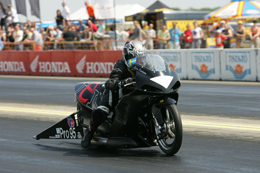
Elvira Karlsson from Sweden - young lady rider who enters the class in 2011 with a fresh competition license.
